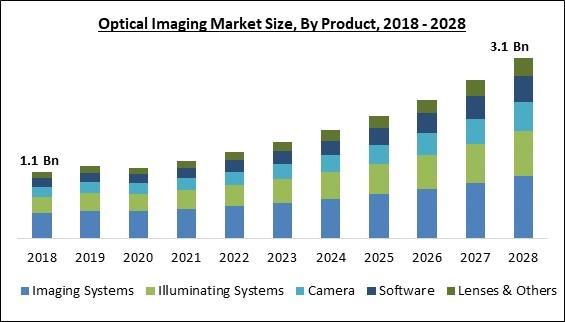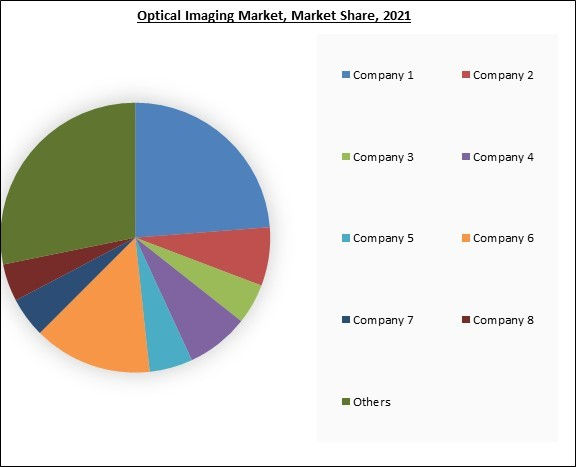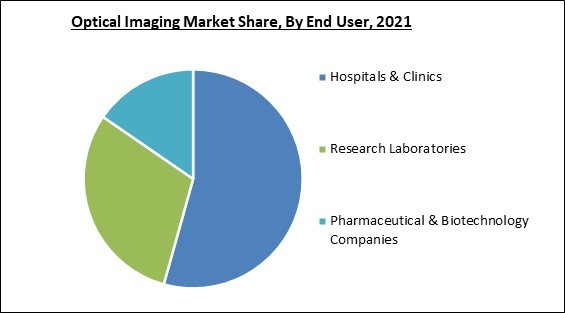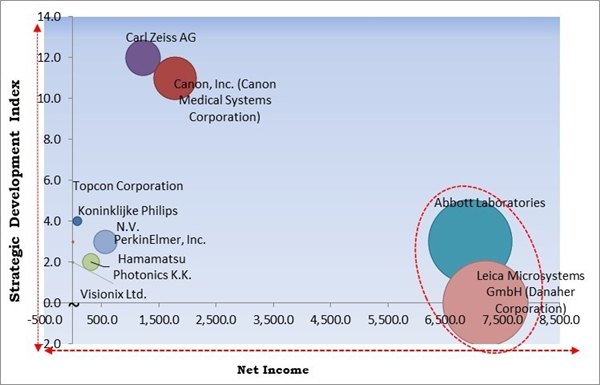The Global Optical Imaging Market size is expected to reach $3.1 billion by 2028, rising at a market growth of 13.1% CAGR during the forecast period.
Optical imaging technologies have great potential for the healthcare sector in terms of improving illness detection, prevention, and treatment. Due to factors such as emerging application areas, increased consumer demand for noninvasive technologies, and an increase in chronic diseases and eye conditions, the market for optical imaging systems is growing. Due to the growing emphasis on early illness diagnosis and the desire for efficient solutions, optical imaging system sales are anticipated to rise quickly.
The science of optical imaging, which employs light to examine cellular and molecular activity in live organisms, is non-invasive and non-ionizing. Electromagnetic radiation, including visible light, contains wave and particle characteristics. Depending on the makeup of the tissue, photons may be absorbed, reflected, or dispersed as they pass through it. Various optical imaging techniques examine these interactions to produce distinctive spectral fingerprints that might provide information about the molecular structure of the target tissue.
For instance, Raman spectroscopy examines the inelastic scattering of light, whereas fluorescence and phosphorescence rely on the emission of light after its absorption. Optical imaging offers a very high spatial resolution in the nanometre (nm) range and may give real-time and quantitative data. Fiberoptic endoscopic probes, which enable tissue lighting and collecting the emitted light from deep inside the body, may partially help overcome this. Moreover, soft tissues exhibit less scattering and absorption in the electromagnetic spectrum's near-infrared (NIR) region than in the visible band, allowing the probing depth to be raised to a few centimeters when utilizing NIR optical imaging.
Fluorescence imaging is used in hybrid tomographic systems like advanced fluorescence-mediated tomography/micro-CT, which provides a useful alternative to traditional PET analysis in drug research. Wide-field NIR fluorescence molecular endoscopy and other device designs have been promoted for enhancing the early detection of esophageal lesions and colorectal adenomas.
The leading players in the market are competing with diverse innovative offerings to remain competitive in the market. The illustration shows the percentage of revenue shared by some of the leading companies in the market. The leading players of the market are adopting various strategies in order to cater demand coming from the different industries. The key developmental strategies in the market are Acquisitions, and Partnerships & Collaborations.
The major strategies followed by the market participants are Acquisitions. Based on the Analysis presented in the Cardinal matrix; Abbott Laboratories and Leica Microsystems GmbH (Danaher Corporation) are the forerunners in the Optical Imaging Market. Companies such as Carl Zeiss AG and Canon, Inc. (Canon Medical Systems Corporation) are some of the key innovators in Optical Imaging Market.
The market research report covers the analysis of key stake holders of the market. Key companies profiled in the report include Carl Zeiss AG, Leica Microsystems GmbH (Danaher Corporation), Abbott Laboratories, Canon, Inc. (Canon Medical Systems Corporation), PerkinElmer, Inc., Topcon Corporation, Hamamatsu Photonics K.K., Koninklijke Philips N.V., Heidelberg Engineering, Inc. and Visionix Ltd.
Optical imaging technologies have great potential for the healthcare sector in terms of improving illness detection, prevention, and treatment. Due to factors such as emerging application areas, increased consumer demand for noninvasive technologies, and an increase in chronic diseases and eye conditions, the market for optical imaging systems is growing. Due to the growing emphasis on early illness diagnosis and the desire for efficient solutions, optical imaging system sales are anticipated to rise quickly.
The science of optical imaging, which employs light to examine cellular and molecular activity in live organisms, is non-invasive and non-ionizing. Electromagnetic radiation, including visible light, contains wave and particle characteristics. Depending on the makeup of the tissue, photons may be absorbed, reflected, or dispersed as they pass through it. Various optical imaging techniques examine these interactions to produce distinctive spectral fingerprints that might provide information about the molecular structure of the target tissue.
For instance, Raman spectroscopy examines the inelastic scattering of light, whereas fluorescence and phosphorescence rely on the emission of light after its absorption. Optical imaging offers a very high spatial resolution in the nanometre (nm) range and may give real-time and quantitative data. Fiberoptic endoscopic probes, which enable tissue lighting and collecting the emitted light from deep inside the body, may partially help overcome this. Moreover, soft tissues exhibit less scattering and absorption in the electromagnetic spectrum's near-infrared (NIR) region than in the visible band, allowing the probing depth to be raised to a few centimeters when utilizing NIR optical imaging.
Fluorescence imaging is used in hybrid tomographic systems like advanced fluorescence-mediated tomography/micro-CT, which provides a useful alternative to traditional PET analysis in drug research. Wide-field NIR fluorescence molecular endoscopy and other device designs have been promoted for enhancing the early detection of esophageal lesions and colorectal adenomas.
COVID-19 Impact Analysis
The COVID-19 pandemic made it more important for physicians and other healthcare workers to maintain social distancing. Due to COVID-19, optical imaging case volumes have rapidly decreased in several imaging and diagnostic departments. The fall in optical imaging cases seriously impacts the short- and long-term economic stability of all practice settings. The need for optical imaging devices has significantly decreased globally because of COVID-19. The large drop in demand for optical imaging equipment is primarily attributable to canceling of elective operations and the closing of hospitals and diagnostic facilities in various nations due to the pandemic. Also, the decline in outpatient visits is anticipated to restrain market expansion throughout the projection period.Market Growth Factors
Technological progress
A cutting-edge optical imaging method that can identify changes in the organization of the collagen fibers in the eye sclera is being developed by biomedical engineers with funding from the government. The technique uses a computer model that links certain alterations in sclera proteins to early-onset glaucoma. The new test will allow for early treatment that preserves eyesight and ongoing non-invasive treatment response monitoring. Engineers are developing an optical imaging device for crucial real-time imaging that detects brain blood flow and metabolic processes, including oxygen use. This supports the growth of the regional market.The leading players in the market are competing with diverse innovative offerings to remain competitive in the market. The illustration shows the percentage of revenue shared by some of the leading companies in the market. The leading players of the market are adopting various strategies in order to cater demand coming from the different industries. The key developmental strategies in the market are Acquisitions, and Partnerships & Collaborations.
Expanding the spheres of applicability
Raman scattering of visible, near-infrared, or near-ultraviolet light provides the basis for Raman spectroscopy. The material's molecular vibrations interact with the laser light, causing energy changes that disclose the substance's chemical composition. Uses include the identification of chemical compounds and the crystal and material structure. Raman gas analyzers are used in surgery to monitor the anesthetic gas mixture. The wide usage of optical imaging techniques for diagnosing and treating various diseases is expected to boost the optical imaging market growth.Market Restraining Factors
Lack of healthcare workers
Health workers are essential to the operation of health systems. Their availability, accessibility, acceptability, and quality are all determinants of expanding healthcare coverage and attaining the right to the enjoyment of the greatest possible level of health. By 2030, the WHO predicts a ten-million-person shortage in the health workforce, mostly in low- and lower-middle-income nations. To varied degrees, governments at all socioeconomic levels have challenges with their workforce's training, employment, deployment, retention, and performance. These elements are assisting the market's expansion in the region.Product Outlook
Based on product, the optical imaging market is segmented into imaging systems, camera, software, illuminating systems and lenses & others. The imaging systems segment dominated the optical imaging market with maximum revenue share in in 2021. This isdue to its extensive use in cancer, ophthalmology, and other fields. These systems are frequently used because they provide real-time, micron-level resolution, 1D depth, 2D cross-sectional, and 3D volumetric pictures at imaging depths of up to a few millimeters and no harmful radiation.Application Outlook
On the basis of application, the optical imaging market is divided into pathological imaging and intraoperative imaging. The intraoperative imaging segment garnered a substantial revenue share in the optical imaging market in 2021. This is owing to intraoperative imaging and monitoring, whichgives doctors access to physiological information that may be used to guide surgery and enhance recovery time and quality of life in the long run. Optical imaging in this context provides extremely practical, portable, affordable, and real-time solutions sensitive to several physiological factors of interest.End-user Outlook
By end user, the optical imaging market is classified into hospitals & clinics, research laboratories and pharmaceutical & biotechnology companies. The research laboratories segment recorded a prominent revenue share in the optical imaging market in 2021. This is due to the increased emphasis on R&D operations to create different new applications of optical imaging. The market is expected to develop as more optical imaging techniques are used in preclinical research and drug discovery procedures. Theincreasing R&D efforts in the life sciences industry will further boost the segment'sexpansion in the forecasted period.Therapeutic Area Outlook
Based on the therapeutic area, the optical imaging market is bifurcated into ophthalmology, oncology, cardiology, dermatology, neurology and others. The oncology segment registered the highest revenue share in the optical imaging market in 2021. This is becausethe optical way of examining tissues can detect both the biochemical and structural aspects of the tissue. It also has the benefits of high sensitivity, low cost, and high resolution. The technique is also gaining popularity since it aids in the early identification of cancer and is non-invasive. As cancer is becoming more common, along with the benefits optical imaging provides in early cancer detection, the segment's growth will surge.Technique Outlook
On the basis of technique, the optical imaging market is divided into optical coherence tomography, near infrared spectroscopy, hyperspectral imaging and photoacoustic tomography. The photoacoustic tomography segment garnered a remarkable growth rate in the optical imaging market in 2021. This is because photoacoustic tomography is ahybrid noninvasive imaging technique for both molecular and functional imaging. In addition, the demand for noninvasive technology is growing, and optical tomography performs better in biomedical imaging than its traditional optical imaging competitors. All these reasons are anticipated tocontributeto the segment'sexpansion in the projected period.Regional Outlook
Region-wise, the optical imaging market is analyzed across North America, Europe, Asia Pacific, and LAMEA. The North America region generated the highest revenue share in the optical imaging market in 2021. This is due tothe availability of qualified people, a strong research infrastructure, and government attempts to support technical improvement in the sector by providing investments and money. Moreover, quicker adoption of technologically improved items in the area is anticipated to accelerate market expansion further.The Cardinal Matrix - Optical Imaging Market Competition Analysis
The major strategies followed by the market participants are Acquisitions. Based on the Analysis presented in the Cardinal matrix; Abbott Laboratories and Leica Microsystems GmbH (Danaher Corporation) are the forerunners in the Optical Imaging Market. Companies such as Carl Zeiss AG and Canon, Inc. (Canon Medical Systems Corporation) are some of the key innovators in Optical Imaging Market.
The market research report covers the analysis of key stake holders of the market. Key companies profiled in the report include Carl Zeiss AG, Leica Microsystems GmbH (Danaher Corporation), Abbott Laboratories, Canon, Inc. (Canon Medical Systems Corporation), PerkinElmer, Inc., Topcon Corporation, Hamamatsu Photonics K.K., Koninklijke Philips N.V., Heidelberg Engineering, Inc. and Visionix Ltd.
Strategies Deployed in Optical Imaging Market
Partnerships, Collaborations and Agreements:
- Jan-2023: Canon came into partnership with ScImage, Inc., a Cloud-native image management company offering services to the healthcare industry. This partnership would enable Canon to leverage Sclmage cloud-driven image management and PACS solutions in enhancing Canon's outreach in hemodynamics empowering it to better serve its customers.
- May-2022: Visionix partnered with Right MFG. Co., Ltd., an innovative medical devices manufacturer, for making growth in their businesses. With this partnership, Right MFG's expertise in offering advanced medical devices would enable Visionix to develop and deliver a product range for eyecare businesses facilitating eye care professionals.
- Mar-2022: Hamamatsu Photonics K.K announced its collaboration with Proscia, a digital and computational pathology solutions provider, to enhance digital pathology embracement. Through this partnership, Hamamatsu's NanoZoomer® series of whole slide scanners for digital transformation would be combined with Proscia's Concentriq® platform to create an open ecosystem for raising the digital pathology embracement ratio in the market.
- Aug-2020: Canon signed a partnership with Zebra Medical Vision, a computer vision startup serving healthcare, to broaden its AI offerings. With this partnership, Zebra Medical Vision's services into the Modality domain would empower Canon to deliver its AI1™ automated imaging analysis solutions to facilitate U.S. clinicians in the delivery of faster, and required diagnoses to patients.
Product Launches and Product Expansions:
- Nov-2021: Koninklijke Philips N.V. unveiled AI-based MR suite of smart diagnostic systems. The MR portfolio would incorporate smart integrated solutions such as MR 7700 3.0T system, developed to accelerate MR examination, smooth workflow, improved diagnostic quality, and provide aid in the optimization of radiology operations.
- Jul-2021: Canon announced the launch of Xephilio OCT-S1, an advanced Wide -field Swept Source Optical Coherence Tomography. Xephilio OCT-S1 would enable customers to capture high-resolution pictures of up to 23 x 20 mm in just one-time scanning. Additionally, it would allow users to use its wide-angle OCT Imaging Angiography feature and delivers OCTA images with enhanced visibility.
- Apr-2021: Abbott unveiled an AI-powered coronary OCT imaging system in Europe. The AI-powered coronary OCT imaging system, developed by integrating imaging technology with AI and would offer surgeons an automated system useful in cardiac procedures, providing information quickly in the course of the placement of coronary stents.
Acquisition and Mergers:
- Jan-2023: Carl Zeiss completed the acquisition of Lenso, an optical 3D metrology manufacturer, to make developments in Zeiss's Industrial Quality and Research division. Through this acquisition, Carl Zeiss's industrial quality solutions would be utilized for Zeiss's Industrial Quality & Research division expansion across Poland.
- Oct-2022: Carl Zeiss acquired GOM Metrology, to serve the UK customer base by providing better tactile and optical technology suite offerings. With this acquisition, GOM Metrology would bring its GOM software, machines, automated 3D coordinate computing technology, and 3D testing to strengthen Zeiss Industrial Quality Solutions' portfolio.
- Oct-2021: Carl Zeiss took over Capture 3D, a 3D Scanning technology, photogrammetry, and automated inspection solutions provider, to make advancements in optical digitization systems. Through this acquisition, Capture 3D's capabilities in supplying required data intelligence for better decision-making would enable Zeiss to better support its customers by providing them the advanced measurement solutions.
- Oct-2021: Canon acquired Redlen Technologies, developer and manufacturer of high-resolution CZT semiconductor detectors. Through this acquisition, Canon would make developments in its medical systems business by getting advanced radiation detection and imaging technology, utilized in CZT semiconductor detector modules, through Redlen Technologies to develop advanced PCCT systems.
- Jul-2021: Topcon Corporation completed the acquisition of VISIA Imaging S.r.l, an Italian-based ophthalmic device manufacturing company. Through this acquisition, VISIA's expertise in manufacturing anterior segment evaluation hardware and software would be leveraged by Topcon to intensify Topcon's manufacturing and innovation capabilities in anterior segment devices and software that would advance Topcon's fundus imaging devices suite.
Scope of the Study
By Product
- Imaging Systems
- Illuminating Systems
- Camera
- Software
- Lenses & Others
By End-user
- Hospitals & Clinics
- Research Laboratories
- Pharmaceutical & Biotechnology Companies
By Technique
- Optical Coherence Tomography
- Near Infrared Spectroscopy
- Hyperspectral Imaging
- Photoacoustic Tomography
By Application
- Pathological Imaging
- Intraoperative Imaging
By Therapeutic Area
- Oncology
- Ophthalmology
- Cardiology
- Dermatology
- Neurology
- Others
By Geography
- North America
- US
- Canada
- Mexico
- Rest of North America
- Europe
- Germany
- UK
- France
- Russia
- Spain
- Italy
- Rest of Europe
- Asia Pacific
- China
- Japan
- India
- South Korea
- Singapore
- Malaysia
- Rest of Asia Pacific
- LAMEA
- Brazil
- Argentina
- UAE
- Saudi Arabia
- South Africa
- Nigeria
- Rest of LAMEA
Key Market Players
List of Companies Profiled in the Report:
- Carl Zeiss AG
- Leica Microsystems GmbH (Danaher Corporation)
- Abbott Laboratories
- Canon, Inc. (Canon Medical Systems Corporation)
- PerkinElmer, Inc.
- Topcon Corporation
- Hamamatsu Photonics K.K.
- Koninklijke Philips N.V.
- Heidelberg Engineering, Inc.
- Visionix Ltd.
Unique Offerings
- Exhaustive coverage
- The highest number of Market tables and figures
- Subscription-based model available
- Guaranteed best price
- Assured post sales research support with 10% customization free
Table of Contents
Chapter 1. Market Scope & Methodology
Chapter 2. Market Overview
Chapter 3. Competition Analysis - Global
Chapter 4. Global Optical Imaging Market by Product
Chapter 5. Global Optical Imaging Market by End-user
Chapter 6. Global Optical Imaging Market by Technique
Chapter 7. Global Optical Imaging Market by Application
Chapter 8. Global Optical Imaging Market by Therapeutic Area
Chapter 9. Global Optical Imaging Market by Region
Chapter 10. Company Profiles
Companies Mentioned
- Carl Zeiss AG
- Leica Microsystems GmbH (Danaher Corporation)
- Abbott Laboratories
- Canon, Inc. (Canon Medical Systems Corporation)
- PerkinElmer, Inc.
- Topcon Corporation
- Hamamatsu Photonics K.K.
- Koninklijke Philips N.V.
- Heidelberg Engineering, Inc.
- Visionix Ltd.
Methodology

LOADING...












